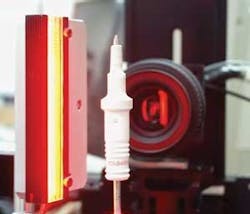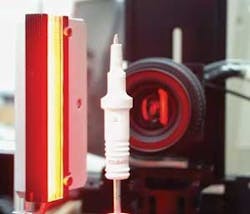Vision systems offer options for auto-part inspection
A discussion with Nigel Holmes of Federal-Mogul
VSD: Federal-Mogul supplies automotive components, subsystems, and systems for OEMs and the aftermarket. What types of problems are you looking at vision systems to overcome in manufacturing? Which types of products require which types of systems?
Holmes: Our intent is not so much to overcome problems as to prevent them. This means we use vision systems, particularly smart cameras and vision sensors, as error-proofing devices throughout the manufacturing process. In this role they are performing mainly feature-verification tasks, such as checking part presence and orientation.
We also use vision to detect process drift. This ensures that we identify problems early and make corrections before time and material are wasted. One example is measurement of soft molded parts. With noncontact gauging we can monitor the process continuously, providing feedback to the upstream operation when adjustment is needed. Smart cameras are appropriate for some of these tasks, but others need the sophistication of PC-based systems.
We also use vision extensively for final inspection. While this includes gauging, presence/absence, and orientation, the emphasis is typically on surface-defect detection. Federal-Mogul makes a lot of parts with curved metal surfaces-pistons, rings, and bearings, for example-and these present significant challenges in terms of surface finish, texture, and coatings. We also produce large quantities of seals and gaskets. These require detection of black features against a black background. In general, for these types of applications we use PC-based systems.
VSD: When your company specifies a vision system, what are the most important choices: speed, support, cost, embedded solution, PC solution, or customer support?
Holmes: The first and most critical issue is function. If a system can’t do what we need it to do, it doesn’t matter how fast it runs or how little it costs. Once the function is achieved, the next issue is speed. Any system we implement must be able to keep up with the rate at which the line runs. After that we look at total cost, vision hardware, part presentation, development, and implementation.
Regarding a preference for an embedded or PC solution, this is not a significant issue. Our manufacturing engineers look for a reliable solution at a low price and are rarely concerned about the platform used.
VSD: There are many types of vision systems today. What benefits and challenges do you see from implementing one or another of these systems?
Holmes: Our general approach is to use the tool most appropriate to the task. This means using vision sensors for straightforward presence/absence applications and ‘high-end’ systems for some of our surface-defect or precision gauging tasks. This ensures that we achieve a solution at the minimum cost necessary.
The difficulty with this approach is that the initial task may change or grow. This ‘scope creep’ can result in requirements beyond the capabilities of the installed system, perhaps due to a lack of processing speed, insufficient resolution, or because the function needed is not available. If this happens on a smart-camera application it can mean purchasing a new camera and developing the application over again.
The benefit to using a more sophisticated, although not necessarily more expensive, PC-based solution is that there is greater flexibility to upgrade. For example, by using FireWire, if we need more resolution we replace the camera rather than the whole system. This means that with every new application it is critical to define exactly what the vision system has to do and then to add in some ‘headroom’ to allow additional functions to be added in the future.
VSD: Could you evaluate the value of different types of smart cameras and vision sensors?
Holmes: Any vision system that is going to be deployed by a manufacturing engineer must have an intuitive, easy-to-use GUI. This is because our engineers are typically not programmers, and, furthermore, we cannot afford prolonged development effort. As a result, most of the systems that we use have a point-and-click approach for application development, and this enables us to minimize the time to implementation.
The situation is different when we are developing a solution for deployment across multiple sites. In this case, our focus is on engineering a robust solution to be replicated at low cost, and it becomes worth investing time in programming to reduce the total project cost.
It boils down to development effort versus number of systems required. The more a vision solution is to be replicated the greater the return from adopting a programming approach. Conversely, for one-off applications, speed of development and implementation are key.
VSD: Do you see technology gaps in the capabilities of current vision systems?
Holmes: We see evolution in all areas, particularly speed and resolution, and we monitor these advances to optimize our return on investment and to address new applications. Specifically, CMOS image quality is still not up to that of CCD although it has features we like such as high dynamic range and low cost. In terms of data-transfer speed, FireWire is sufficient for most of our applications, and when we need more there’s Camera Link. Higher-speed FireWire and GigE are going to be interesting, particularly if they can help us avoid the cost of a frame grabber and cable.
Taking this a step further, a FireWire or GigE linescan camera would be interesting. With processing speed there’s a tendency to use all that’s available. This means that as smart cameras get faster we can run more complex algorithms and do more processing. User interfaces can still be intimidating for the occasional vision system user. These continue to evolve but a setup wizard to guide the engineer through his specific application would be useful.
Other areas where we would like to see improvements are in 3-D imaging of surface topology and surface analysis, particularly in terms of dealing with complex or variable textures. There are commercially available tools in these areas but they tend to be too slow or too expensive for production.
VSD: Do you qualify, design, build, or RFP the imaging systems that you develop or install?
Holmes: We start with a three-question filter: Is this a vision application and is no other technology more appropriate? How difficult or challenging is the application? Is a solution available or could one be provided by an integrator at an acceptable level of price and performance? Sometimes these questions can be answered quickly, but often a feasibility study is needed, which we carry out in our lab. If the answers are yes, not very, and yes-which covers probably 70% of the proposed applications-then we will support the manufacturing operation in documenting the application requirements, soliciting, and subsequently reviewing proposals from qualified vendors.
If our initial study identifies some particular challenges-technical or economic-or if no credible vendor response is received, then we will consider an internal development project. If there is a clear return on investment, we will carry out a more extensive feasibility study and from there go to proof-of concept. However, we do not engineer part-presentation systems. That work goes to material-handling experts within our company or outside, and they, as part of the project team, take care of design and build, while working to meet the requirements of the vision solution developed in-house.
VSD: Are you developing or thinking of developing any vision products internally that might be of value to the commercial market?
Holmes: Federal-Mogul is an end user, so the answer is no. However, we are constantly looking for ways to configure low-cost and easy-to-use systems from commercially available components. Our approach is to leverage the economies of scale of PC production-Windows running on PC platforms with USB and FireWire interfaces-coupled with inexpensive cameras and proprietary software. In addition, we will develop our own algorithms to solve problems specific to our products and processes.
VSD: How do you interact with manufacturers or integrators? What opportunities exist for interaction and what additional changes are needed to make system integration easier?
Holmes: We periodically attend vision shows to stay current with new products, new capabilities of existing products, and new vendors. We also regularly review trade publications for items relevant to current or potential vision applications. Regarding work with machine integrators, most of our application solutions are developed by teaming with one or several integrators to combine the appropriate talents for the best solution with the lowest risk.
The integration industry comprises many small and regional companies, and this does create some problems for us. We need to work with those who can provide both local support and global reach, whether through their own resources or partner networks.
VSD: Are there any technologies or capabilities that you would like to see implemented in future products from your suppliers?
Holmes: It would be interesting to see greater tie-in between conventional image-processing suppliers, such as Cognex, Matrox, and National Instruments, and nonoptical image-acquisition devices, such as x-ray, ultrasound, 3-D, and thermal imaging. Also, we could use improved surface-inspection tools.
Nigel Holmes is responsible for the Sensors & Signal Processing Group at Federal-Mogul Corporation (Southfield, MI, USA; www.federal-mogul.com). He has a B.Sc. in engineering production from the University of Birmingham, UK, and more than 20 years manufacturing-industry experience-12 in the automotive sector. Editor in chief Conard Holton spoke with him about seeking inspection solutions at a low price.


